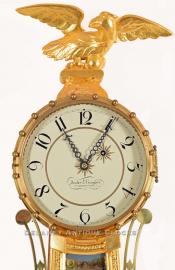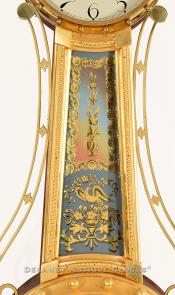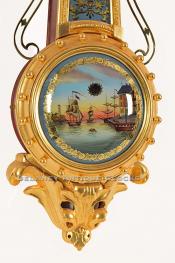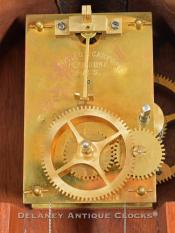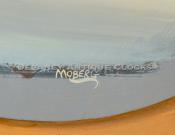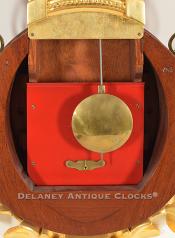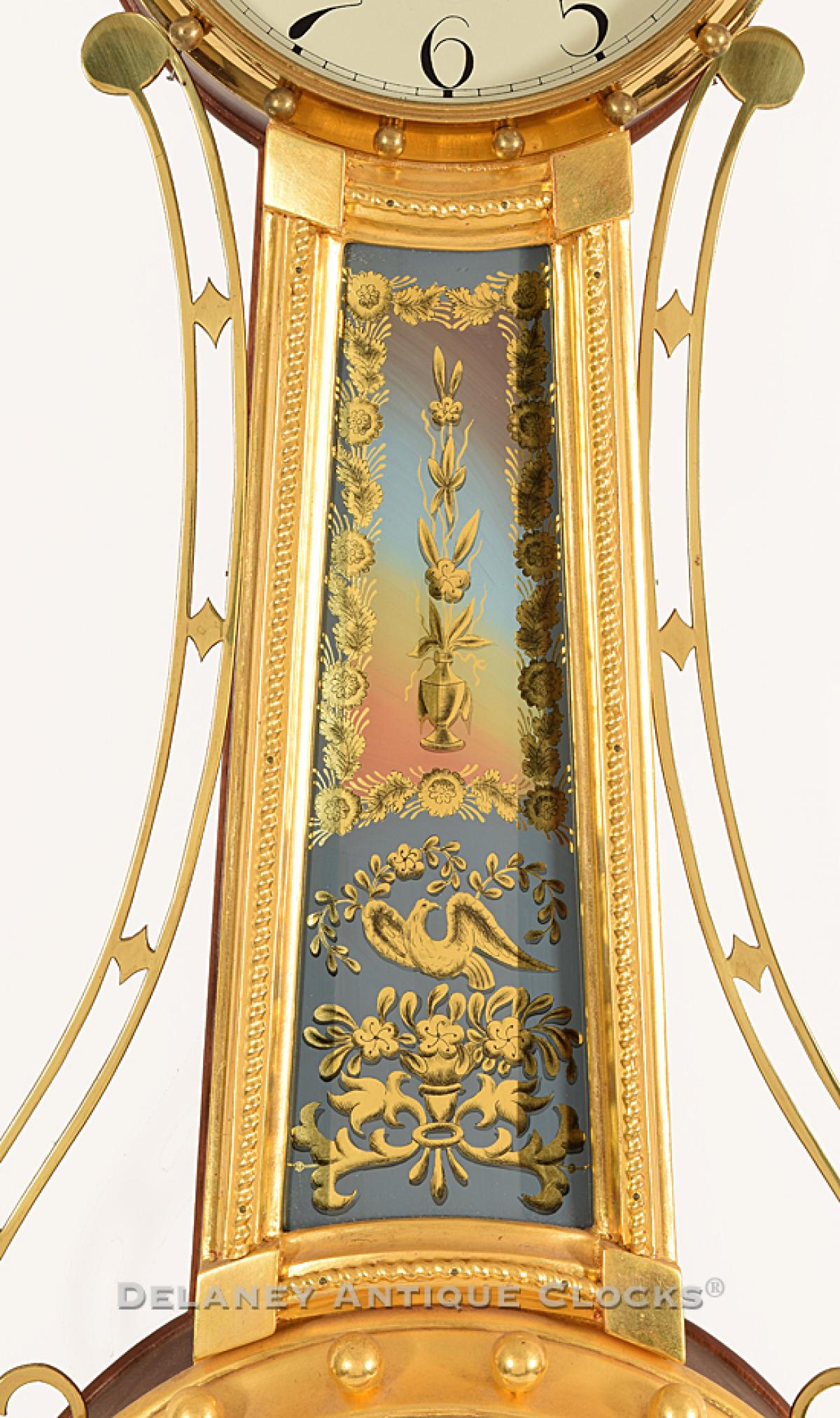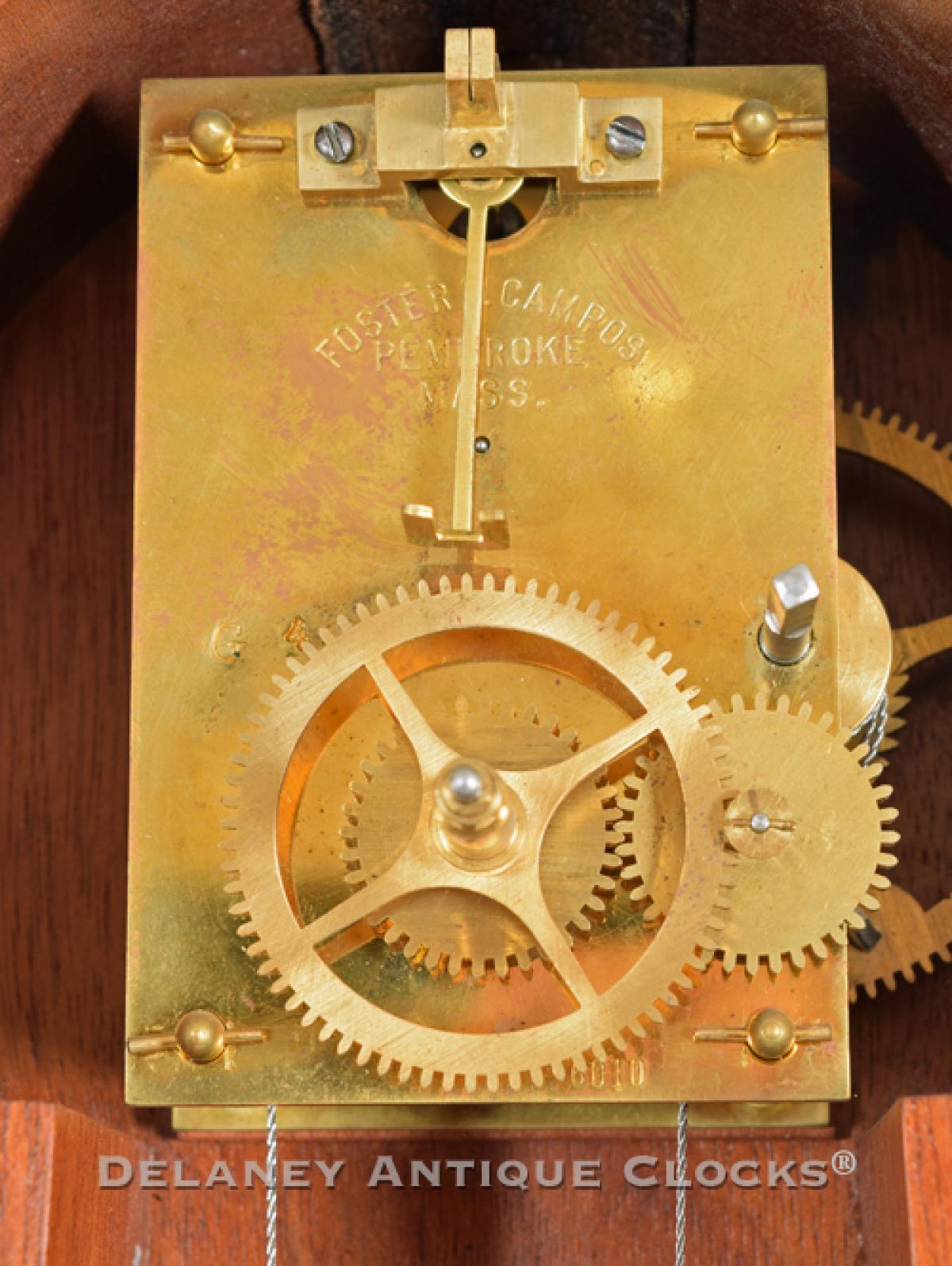Foster Campos Girandole Wall Timepiece. Pembroke, Massachusetts. 220104.
Foster S. Campos of Pembroke, Mass made this very attractive reproduction Girandole Wall Timepiece. This timepiece was made in 2004 and was Foster's first girandole that year. This information is stamped on the inside of the case in his code. This beautiful American form was originally developed by the Concord, Massachusetts, Clockmaker Lemuel Curtis in about circa 1820 and was patented by him. The case style and format are closely related to the girandole wall mirrors of the period.
Lemuel Curtis was a very talented apprentice of the Willard family. His apprenticeship started in 1802. In 1811, it is recorded that he moved to Concord, Massachusetts, and set up shop there as a Clockmaker. Here, he specialized in the production of finely made timepieces. Over the years, he made several improvements to Simon Willard's original design. An example of such an improvement is the single screw movement mounting system. The Curtis design used a screw to mount the movement to the case from the back of the backboard. This screw held the movement in place. Willard's design used two screws diagonally positioned in the movement plates and screwed directly into the wood of the backboard from the front. Over time, the threading of the wood in the backboard tends to fail, and ultimately the original screws are often replaced. Lemuel's ultimate achievement would have to be the design of this Girandole form, often called America's most beautiful clock. However, this model was not a financial success. As a result, a small number were originally produced. Most of which are in the collections of our country's best museums. Two fine examples are displayed at the Museum of Fine Arts in Boston. Another example can be seen in the clock collection of Old Sturbridge Village in Sturbridge, MA. A fourth Girandole Clock by Lemuel Curtis is at the Sterling and Francine Clark Art Institute in Williamstown, Massachusetts.
Many reproductions of this original Curtis form have been made. The Waltham Clock Company made approximately 30 examples in the 1920's. Since the 1970s, individuals like Elmer Stennes, Ted Burleigh, and Foster Campos all produced limited copies of the original form.
This case measures approximately forty-six inches long. The case is constructed in mahogany and is finished in shellac on the sides. The frames, carved finial plinth, eagle finial, and presentation bracket are wonderfully gilded in gold leaf. The condition of the gilding is excellent. You will also find that the case is die-stamped "1 -04" on the frames of the lower box. Foster Campos employed this numbering and dating system to date his clocks. 1 for the first clock of the series. 04 for the year that it was manufactured. It also has his stamp featuring the banjo clock on the inside of the backboard. The two gilded frames are fitted with colorfully painted tablets of traditional themes. The artistry level is very high. Both glasses are convex or bowed and were painted by Tom Moberg. The shaping of the glass makes it very difficult to photograph without getting reflections. The background or fields are gray-blue. The throat tablet features intricate designs that include florals, urns, and a bird. The bottom circular tablet depicts a harbor or dock scene. The view contains four sailing ships, two people in a rowboat, a brick three-story building, and a lighthouse set atop a bluff. The wharf depicts some of the commerce being done during colonial times. The coloring and detailing are first-rate. An oval aperture in the sky allows one to see the motion of the brass-faced pendulum bob. This tablet is signed on the back by the artist, "Moberg."
A piece of convex glass protects the painted iron dial. This is fitted into a brass bezel decorated with 20 individual brass balls. The dial is painted, and the design features a closed minute ring; please note the evergreen tree in the 6:20 position, large Arabic-style hour numerals, a gilt ring, and additional gold work decorating the openings around the center and winding holes. The clockmaker's signature reads, "Foster S. Campos / PEMBROKE, MASS." The hands are a traditional Lemuel Curtis form, having concentric circles and barbed pointers. The sidearms on the case are brass and are nicely formed.
The movement is brass and die-stamped by "KILBOURNE & PROCTOR / INC., / G" on the front plate. It is weight-powered and is designed to run for eight days on a full wind. The weight of this clock is lead and is most likely a replacement. This movement is mounted to the back of the case with two screws. It is also supported on a metal seat-board that traverses the frame rails inside the case. The steel pendulum rod supports a decorative bob. The pendulum tie-down is in place.
This clock is approximately 46 inches long, 13 inches wide, and 6 inches deep.
Inventory number 220104.


